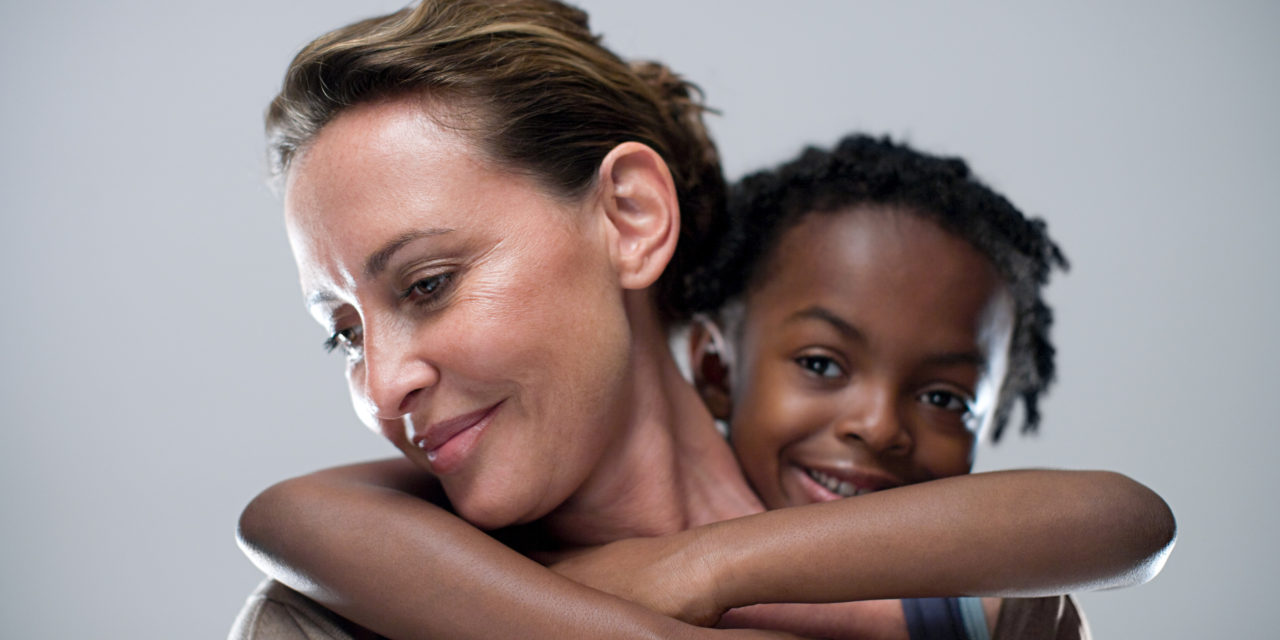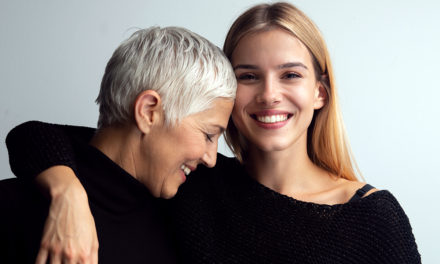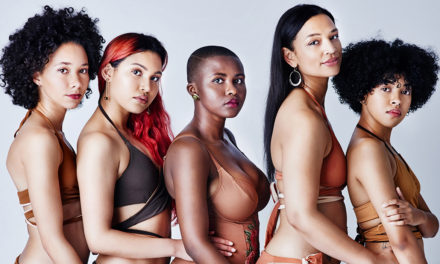A mother’s intuition. That was something that Capital Health oncology nurse Trish Tatrai felt before even meeting her daughters. After months of auditioning adoption agencies, Tatrai and her husband, Steve, were attending an information session at Cradle of Hope when they felt an almost palpable sense that this was “the place for us.” Over the next 5 years, the agency would help the couple prevail over myriad challenges to welcome two young Russian girls—Ali and Natasha—into their Hamilton Square, N.J., home. Today, the girls are seniors in high school, engaged with their peers and looking at colleges, but it took a lot of love and patience to get here.
Though Tatrai, RN, MS, OCN, CBCN, still bristles at poorly worded or insensitive questions (Are they real sisters? Of course. Are you their real mom? I’m their adoptive mom, and yes.), she is happy to share what she has learned. To a point. “I always tell my girls that it’s their story,” says Tatrai, who secured their permission before agreeing to this article. “What we share is up to them.”
“Our daughters’ adoptions were two totally different experiences,” says Tatrai. “We adopted our younger daughter first. We kind of did it backward.” The Tatrais’ adoption story is one of the hundreds of thousands unfolding each year. And each one is completely unique, intricate, and currently uncountable. According to the Child Welfare Information Gateway, nearly 136,000 adoptions happened in the United States in 2008, but that’s just a guess because, according to the site, there’s “no straightforward way to determine the total number of adoptions, even when multiple data sources are used.” This, in part, is thanks to the variety of types of adoptions available, including public, private, intercountry, tribal, and nonagency, the latter of which includes adoptions by stepparents or relatives. “The hardest part is deciding which type of adoption is right for you,” says Tatrai. “We went to many all-day seminars and workshops. There are a lot of choices.”
In the fall of 1999, the Tatrais put their faith in Cradle of Hope to help them find a daughter to call their own. The nonprofit facilitates adoptions that are international (now mainly from China) as well as domestic (primarily from the Washington, D.C., metropolitan area). Once the Tatrais signed with the agency, their adoption journey truly began—not with purchasing plane tickets but with wending their way along a global paper trail.
Pushing Paper
“I tell people, ‘That was my labor—the paperwork,’” laughs Tatrai. “You have to jump through hoops. They give you a whole portfolio of information to provide before they even accept you as an adoptive parent.” Most prospective parents are asked to participate in a home study that includes probing interviews about everything from finances to religious beliefs. Would-be parents usually must submit letters of reference and obtain medical clearances and criminal background checks. “I bought a big file box to get myself organized,” says Tatrai. “Cradle of Hope gave us a timeline of what we needed to do. We divided up the work and kept on top of it.” The agency also helped secure translators for Russian documents—an extra wrinkle common in some intercountry adoptions.
Perhaps the most important document, though, was the photo the couple received showing 6-month-old Natasha. “That gave us even more incentive to do whatever we needed to get done because we knew she was waiting for us,” says Tatrai. Over the next few months, the Tatrais continued their new routine: Complete paperwork. Pay fees. Repeat. She also notified her boss and the human resources department at Capital Health: “If I got a phone call, I needed to take off immediately,” she says. “I had all the paperwork filled out, except for the date.”
Finally, 8 months after the Tatrais first saw Natasha’s picture, they brought their daughter home. Her homecoming was not without challenges, though. First, the Tatrais didn’t rush out and purchase baby supplies for Natasha until they had a court date—one of the last steps in finalizing the adoption. Second, when they arrived in Russia to get Natasha, they learned (surprise!) that she was walking.
This necessitated a quick trip to a Russian shoe shop so they could return Natasha’s current footwear, which was from the cache of clothing that was shared by all the orphans. Not knowing Natasha’s clothing size also meant borrowing an assortment from friends before the trip.
Once they had all their toddler supplies in place, the couple took Natasha to a pediatrician to be re-vaccinated and undergo an evaluation, which she passed with flying colors. “We were willing to accept whatever was given to us,” says Tatrai. “But we were very lucky.”
Tatrai says they relied heavily on pointing when they first brought Natasha home. Given her age, transitioning to a different language wasn’t an issue since her first words were in English. What’s more, Natasha’s early upbringing enabled her to converse with the Tatrai’s second (and older) daughter, Ali, who was adopted at age 6. “Natasha had the accent and everything,” adds Tatrai. A Russian-English picture dictionary also helped bridge the language gap for Ali.
Adoption Redux
For Trish’s husband, Steve, who was an only child, their second adoption was inevitable. “He wanted a sister for Natasha,” says Tatrai. As older parents, the couple wasn’t keen on a repeat of toddlerhood, so in 2003 they asked Cradle of Hope to match them with a 5- or 6-year-old girl. Much about the process was, thankfully, familiar. Paperwork. Fees. The Russian court system. Even their judge and driver in Russia were the same. By a stroke of luck, the agency found 6-year-old Ali from a town close to where Natasha was born, so the family was able to visit with the same doctors who had cared for Natasha as a baby.
Still, the Tatrais faced a new set of challenges in adopting Ali. To place older children, Cradle of Hope runs a program called Bridge of Hope that ensures families and children are well-matched by bringing orphans (usually ages 7 to 13) to America for a month to live with hosts who, unbeknownst to the kids, are their prospective families. “It was the hardest day of my life when Ali had to go back to Russia,” says Tatrai. “I’ve asked her since, ‘Did you think we were coming back for you?’ and she said no.” When their court date was set, Trish and Steve immediately sent word to Ali through other parents. “She kept saying, ‘America home. America home,’” says Tatrai. “She was ready to come with us.”
When she arrived, Ali was eager to put her past behind her. “As she settled in, she didn’t want to talk about Russia, but I told her, ‘You need to tell me the memories so I can give them back to you when you’re older.’ I always tell my kids that they need to be proud of where they came from. That’s part of them.” To help with the transition, the Tatrais also sought support from the Adoptive Parents Organization of Central Jersey (APO). “Adoption can be a challenge,” says Tatrai. “Talking with people who have that understanding is very helpful.” Through APO, the Tatrais built enduring friendships and benefitted from practical workshops on topics including how to handle kids’ cruel remarks. “As they grow older, it doesn’t happen as much,” she notes.
Now when people ask Tatrai if the girls are twins or make some other off-the-cuff remark, she doesn’t “tell everybody the story.” As an adoptive parent, she asserts, you must choose what you do and don’t reveal. “People also say that the girls look like me,” adds Tatrai, who has the same brown eyes and hair as her girls. “We just kind of chuckle.”
“People say that our girls are lucky,” says Tatrai, who now works as the clinical manager in oncology and as the breast health navigator for Capital Health Medical Center – Hopewell. “They have had opportunities they may not have had, but I say Steve and I are the lucky ones. The girls came to us. It was all in someone else’s hands, and it worked out. They were meant to be ours.”
Another Approach to Adoption
“My husband, Joe, and I became foster parents almost a year to the day after we got married,” says Danielle Gletow, creator of One Simple Wish, a nonprofit that helps children in the foster system fulfill their needs and desires. “We knew it would be a rocky road, but there are so many children who need good homes.” According to preliminary data from the Administration on Children, Youth, and Families (acf.hhs.gov), almost 428,000 children in the U.S. were in foster care in 2015. “For us, it was a no-brainer,” says Gletow. “That was the way we wanted to go.”
So, the couple began fostering in 2006, caring for three little boys—one for 3 months, another for 5, and then a newborn boy for a few days. “It’s a risk when you take a foster child,” she says. “There’s no guarantee you can adopt, and that’s painful. That is what led us to have our biological child, Liliana.” Mia came to the Gletows in September 2007, 3 days after she was born and 2 weeks before Gletow became pregnant with Lily.
Taking in a foster child is not a decision to enter lightly, she cautions: “You can very easily fall in love with them, and it can be gut-wrenching when they leave.” There is a 15-month period by which the decision must be made to “find permanency,” either through adoption or reunification. However, Gletow adds, Mia’s adoption took 2 years to finalize, despite the fact it was uncontested.
“People entering into the system should know it’s not a fairy tale, but I’d do it over again in a heartbeat,” she says. And she hopes to inspire others to do the same. “There are currently more children in foster care than there are foster parents,” says Gletow. “Our child-welfare system needs more quality foster parents.” This includes adults who do and do not have adoption as an end goal. Gletow encourages starting with these sites: ultimatewish.org, davethomasfoundation.org, and adoptuskids.org.
For people who aren’t currently interested in fostering, Gletow suggests visiting the website onesimplewish.org. She founded this nonprofit as a way to grant wishes to children in foster care. You can also investigate volunteering as a court-appointed special advocate (CASA), which is important because CASA volunteers stand up for kids in court (casaforchildren.org).
“Everybody really could be and should be doing something,” says Gletow. When you grant a wish, for instance, she says it gives a sense of hope to the child on the receiving end. “That’s a start,” says Gletow. “If everybody could do something, we could really make a significant change.”





